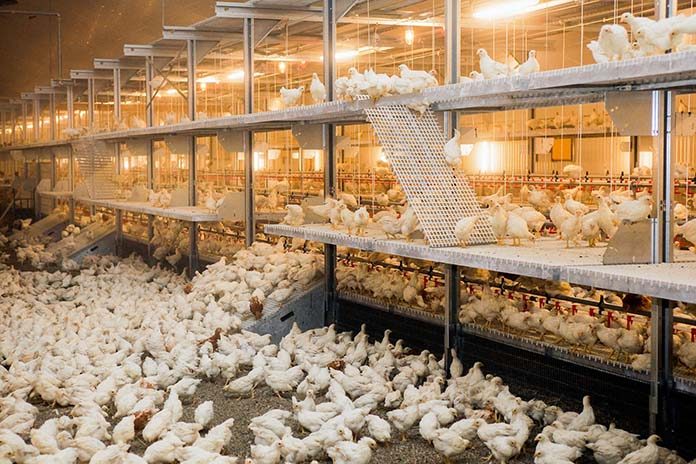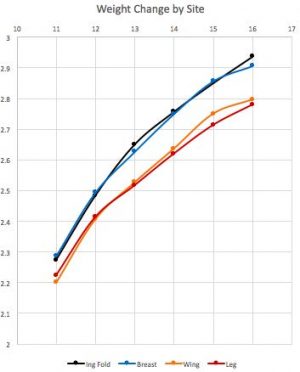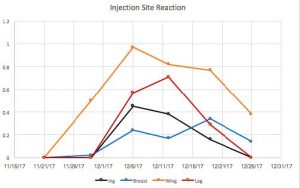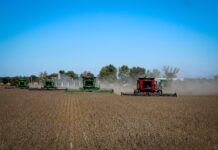
As commercial pullets farming transitions from rearing a bird on a single level in conventional–style housing to rearing a bird in a multi–level aviary, conventional methods of production must also be adjusted to assure a pullet her best chance of success. Among the methods that can be examined are the procedures for administering injectable vaccines. Commercially reared egg-laying pullets are commonly vaccinated against Salmonella enteritidis with a program including the intramuscular injection of a Salmonella enteritidis bacterin. While individual farming programs may utilize one of a number of potential intramuscular vaccination sites, no data has been published comparing the immune and physiologic responses between sites, or how the choice of injection site may affect successful rearing in aviary versus conventional housing.
In order to determine if there is a difference in physiologic and immune response between commercially-reared leghorn pullets injected with S. enteritidis bacterin vaccine in the muscles of the upper wing, the breast, the leg, and the space under the skin at the groin, 124 12-week–old pullets from a conventional, belted pullet barn were selected. Pullets were housed in three adjacent columns of cages of three tiers, each cage housing 11-15 pullets. All pullets received the same trivalent vaccine against Newcastle Disease, Bronchitis, and Se on the same day from the same administrator. One column of three cages was injected in the wing, one in the breast, and one under the skin of the groin. The rest of the pullets in the barn were injected in the leg, the farm’s standard procedure. Starting on the day that the vaccine was administered, the pullets were monitored weekly for six weeks for changes in weight and injection site inflammatory reaction (swelling and color change). Blood samples were collected at 5, 30, and 60 weeks post injection for analysis of antibody titers to the vaccine. The injection under the skin of the groin used a needle guard to guide in injection the vaccine just under the skin, avoiding the muscle. Data for the leg–injected group was calculated from the flock averages.
Over the initial six weeks of the study, pullets that were injected under the skin in the groin gained an average of 0.67 pounds, pullets injected in breast muscle gained an average of 0.62 pounds, pullets injected in the wing gained an average of 0.60 pounds, and pullets injected in the leg gained an average of 0.56 pounds. Early visual analysis of weight changes between the four groups suggests a difference in the rate of gain in addition to the total amount gained, with gr oin and breast injected pullets gaining weight at a faster rate than the wing and leg injected pullets (Figure 1).
 Over the initial six weeks of the study, pullets injected in the groin experienced the largest number of inflammatory reaction two weeks post injection, with 45% of the group experiencing noticeable swelling and color change. Pullets injected in the breast experienced the largest number of inflammatory reaction four weeks post injection, with 34% of the group experiencing noticeable swelling and color change. Pullets injected in the wing experienced the largest number of inflammatory reaction two weeks post injection, with 97% of the group experiencing noticeable swelling and color change. Pullets injected in the leg experienced the largest number of inflammatory reaction three weeks post injection, with 71% of the group experiencing
Over the initial six weeks of the study, pullets injected in the groin experienced the largest number of inflammatory reaction two weeks post injection, with 45% of the group experiencing noticeable swelling and color change. Pullets injected in the breast experienced the largest number of inflammatory reaction four weeks post injection, with 34% of the group experiencing noticeable swelling and color change. Pullets injected in the wing experienced the largest number of inflammatory reaction two weeks post injection, with 97% of the group experiencing noticeable swelling and color change. Pullets injected in the leg experienced the largest number of inflammatory reaction three weeks post injection, with 71% of the group experiencing
noticeable swelling and color change. At five weeks post injection the groin and leg injected pullets had apparently resolved to 0% with an inflammatory reaction, the breast injected to 14% with an inflammatory reaction, and the wing injected to 38% with an inflammatory reaction (Figure 2).
 Blood was drawn to measure serum titer response to the vaccine at five and six weeks post injection, with follow-up serum titer analysis planned for 30 and 60 weeks post injection. Early analysis of five and six week titers suggests that titers are protective in all four study groups.
Blood was drawn to measure serum titer response to the vaccine at five and six weeks post injection, with follow-up serum titer analysis planned for 30 and 60 weeks post injection. Early analysis of five and six week titers suggests that titers are protective in all four study groups.
At the conclusion of the data collection period, results were compared to a 2016 study by the author comparing responses between injection in the leg and the breast. The 2016 study suggested that breast injection of the trivalent Se bacterin vaccine was a beneficial procedure for pullets raised in a multi–level aviary as there less incidence of inflammatory reaction. Less inflammation means less pain, which is expected to support the vertical movement required for pullets to access feed and water in a multi–level aviary system.
From the Proceedings of the Midwest Poultry Federation Convention
















